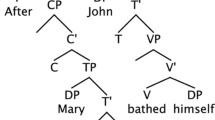Abstract
We propose that, for the human parser, recovery from garden paths consists in repairing the structure built so far, rather than reparsing the input. The difficulty of a repair is attributable not to the cost of effecting the structural alterations but to the cost of deducing which alterations are needed. The parser must diagnose its error in order to correct it. The error is signaled by an input word that is incompatible with the current structure; this is the symptom from which the diagnosis must be made. If the error is transparently clear from the nature of the symptom, recovery is easy; but sometimes the necessary reasoning is obscure, and then the diagnosis is unsuccessful and the garden path persists. Unlike other repair models, the diagnosis model needs no special mechanism for revising garden path analyses. The garden path recovery device is the same machine as the first-pass parser, merely set into emergency mode. When faced with a breakdown the parser does not stop its normal activities and enter a new mode of reasoning to detect what went wrong. It simply continues to parse, attaching the problematic input item in the least ungrammatical way it can, despite the conflict with previously built structure. This conflict is productive; it provokes adjustments to the existing structure. In successful cases, one adjustment leads to another until a stable state is reached, at which point the original error will have been eliminated. Examples suggest that the parser gives more weight to syntatctic than to pragmatic acceptability; only a syntactic clash between the input and the existing structure sets the adjustment process in motion.
Similar content being viewed by others
References
Abney, S. (1987). Licensing and parsing. In J. McDonough & B. Plunkett (Eds.),Proceedings of the Northeastern Linguistics Society (Vol. 17). Amherst: University of Massachusetts.
Carlson, G. N., & Tanenhaus, M. K. (1988). Thematic roles and language comprehension. In W. Wilkins (Ed.),Syntax and semantics.Vol. 21:Thematic relations. New York: Academic Press.
Dowty, D. (in press). Deductive versus semantic accounts of reasoning: The relevance of negative polarity and negative concord marking. InProceedings of the Chicago Linguistic Society.
Ferreira, F. & Henderson, J. M. (1991a). Recovery from misanalyses of garden-path sentences.Journal of Memory and Language, 30, 725–745.
Ferreira, F., & Henderson, J. M. (1991b). How is verb information used during syntactic parsing? In G. B. Simpson (Ed.),Understanding word and sentence. Amsterdam: Elsevier Science Publishers B. V., North-Holland.
Fodor, J. A. (1983).The modularity of mind. Cambridge, MA: MIT Press.
Fodor, J. D., & Inoue, A. (1994).Symptoms and diagnoses in sentence processing. Unpublished manuscript.
Fodor, J. D., & Frazier, L. (1980). Is the human sentence parsing mechanism an ATN?Cognition, 8, 417–459.
Frazier, L., & Rayner, K. (1982). Making and correcting crrors during sentence comprehension: Eye movements in the analysis of structurally ambiguous sentences.Cognitive Psychology, 14, 178–210.
Gibson, E. A. F. (in press).Memory limitations and sentence processing breakdown. Cambridge, MA: MIT Press.
Gorrell, P. (in press).Syntax and perception. Cambridge, England: Cambridge University Press.
Green, G. M. (1971). Unspeakable sentences: Book 2.Linguistic Inquiry, 2, 601–602.
Inoue, A. (1985). On the sentence processing of Japanese. Unpublished ms., University of Connecticut.
Inoue, A. (1991). A comparative study of parsing in English and Japanese. Unpublished Ph.D. dissertation. University of Connecticut.
Inoue, A., & Fodor, J. D. (in press). Information-paced parsing of Japanese. In R. Mazuka and N. Nagai (Eds.),Japanese sentence processing. Hillsdale, NJ: Erlbaum.
Kimball, J. (1973). Seven principles of surface structure parsing in natural language.Cognition, 2, 15–47.
Langendoen, D. T. (1976). A case of apparent ungrammaticality. In T. G. Bever, J. J. Katz, & D. T. Langendoen (Eds.),An integrated theory of linguistic ability. New York: Thomas Y. Crowell.
MacDonald, M. C. (1994). Probabilistic constraints and syntactic ambiguity resolution.Language and Cognitive Processes, 9, 157–201.
Pearlmutter, N. J., & MacDonald, M. C. (1992). Plausibility and syntactic ambiguity resolution. InProceedings of the Fourteenth Annual Conference of the Cognitive Society (pp. 498–503). Hillsdale, NJ: Erlbaum.
Pritchett, B. L. (1992).Grammatical competence and parsing performance. Chicago: University of Chicago Press.
Rayner, K., Carlson, M., & Frazier, L. (1983). The interaction of syntax and semantics during sentence processing: Eye movements in the analysis of semantically biased sentences.Journal of Verbal Learning and Verbal Behavior, 22, 358–374.
Shapiro, L. P., Zurif, E., & Grimshaw, J. (1987). Sentence processing and the mental representation of verbs.Cognition, 27, 219–246.
Stevenson, B. (1994).Ungrammaticality and stages in sentence processing. Unpublished doctoral dissertation, Monash University, Monash, Australia.
Stowe, L. A., Kaan, E., Culicover, P., & Torello, M. (1994).Predicate argument structure, subcategorization or world knowledge? Paper presented at the Seventh Annual CUNY Conference on Human Sentence Processing, New York.
Trueswell, J. C., Tanenhaus, M. K., & Garnsey, S. M. (1994). Semantic influences on parsing: Use of thematic role information in syntactic disambiguation.Journal of Memory and Language, 33, 285–318.
Weinberg, A. (in press). Licensing constraints and the theory of language processing. In R. Mazuka and N. Nagai (Eds.),Japanese sentence processing. Hillsdale, NJ: Erlbaum.
Author information
Authors and Affiliations
Rights and permissions
About this article
Cite this article
Fodor, J.D., Inoue, A. The diagnosis and cure of garden paths. J Psycholinguist Res 23, 407–434 (1994). https://doi.org/10.1007/BF02143947
Issue Date:
DOI: https://doi.org/10.1007/BF02143947




